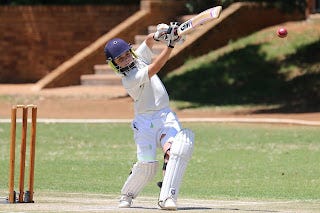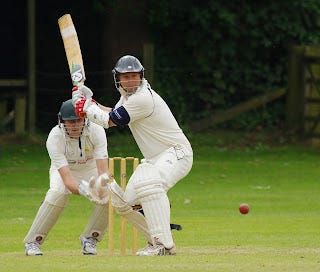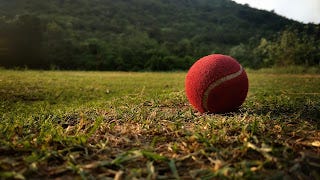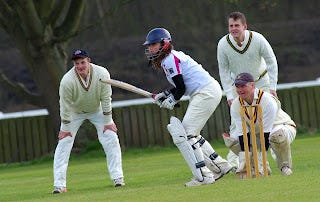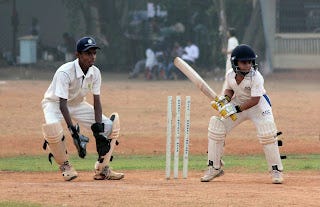The Famous Families of Cricket
This post may contain affiliate links and I may earn a small commission when you click on the links at no additional cost to you. As an affiliate, I earn from qualifying purchases.
In cricket there have been some famous families which have produced a number of well known players. In India there is the Amarnath family consisting of the patriarch Lala and his three sons Mohinder, Surinder and Rajinder. There are several cases of two brothers representing their country or a father and son duo or an uncle and nephew but these cases cannot be classified as big family units.
In Pakistan the largest family unit is the Mohammad family of cricketers who have scored 36 Test centuries for Pakistan. Three of the family hit double centuries for Pakistan and Hanif Mohammad also scored a triple century. Ameer Bibi, mother of the brothers, was a national badminton champion and a regional level tennis champion.Hanif held the record for the highest score in first class cricket (499) until Brian Lara went past him by scoring 501 not out.
Four out of the five Mohammad brothers played Test cricket for Pakistan. The fifth, Raees Mohammad, came close as he was the 12th man in the first Test at Dhaka of the Pakistan versus India series of 1954-55. Later Shoaib Mohammad, son of Hanif, played 45 Tests and 63 ODI matches for Pakistan. He scored seven centuries in Test cricket.
At least two of the Mohammad brothers played together in a Test on 64 occasions. Hanif and Wazir played together in 18 Tests, Hanif and Mushtaq in 19 Tests, Wazir and Mushtaq in one Test and Mushtaq and Sadiq in 26. In one of these 64 Tests three brothers, namely Hanif, Mushtaq and Sadiq playedtogether. This was against New Zealand at Karachi in October 1969.
In the first 89 Tests that Pakistan played there was always a member of the Mohammad family in the team. This spanned a period of 25 years and 84 days from 16th October 1952 when Pakistan played its inaugural Test against India at Delhi to the end of the Pakistan versus England Test played at Hyderabad from 2nd-7th January 1978.
In fact at least one Mohammad brother played for Pakistan in 100 of its first 101 Tests. These are remarkable spans, without parallel, in the history of Test cricket.
Together these five Test playing members (four brothers and Shoaib) of the Mohammad family have played 218 Tests between them, scoring a total of 13643 Test runs and 36 Test centuries. They have also scored 89,922 runs and 226 centuries between them in first-class cricket.
Hanif was an incredibly focussed batter whose one and only goal in life was to post huge scores in cricket matches at whatever level he was playing. He represented Pakistan in 55 Test matches from 1952 to 1969. He scored steadily at an average of 43.98. Unfortunately for him, his career was spread over a period when Pakistan played very few Test matches so that he was able to play only 55 matches in his 17 year career. In his early years his coach was Abdul Aziz Durrani (popularly known as Master Aziz) who was the father of Indian Test cricketer Salim Durrani.
He had an obsession and it was this single minded focus that took him to great heights. A teammate has described an incident about him which illustrates Hanif's determination and dedication. The player has written that on one occasion in a minor match, Hanif played a perfect defensive shot but the ball swerved due to a strong breeze, found its way past Hanif's bat and crashed into the stumps.
Hanif was grief stricken by that dismissal. Although it was just a minor match he could not forgive himself. That night there was a party to which the entire team was invited. But Hanif excused himself and shut himself away in his hotel room. The rest of the team went for the party and when they returned to the hotel they found Hanif padded up and practicing the same shot in front of a mirror.
He went through the motions hundreds of times, forcing the correct movements into his instrict so that the next time he faced the same delivery, he would play the shot perfectly and without hesitation or error. That was what Hanif was like the teammate says. Hanif took his cricket more seriously than he thought about himself or his life.
In 1959 while playing in the Qaid-e-Azam trophy for Karachi against Bahawalpur he overtook Don Bradman's world record for the highest ever individual score in first class cricket. It happened at the Parsi Institute ground in Karachi which had a dusty and hard baked outfield and a placid pitch.
Bahawalpur batted first and were all out for 185. Then Hanif opened the innings for Karachi and just went on accumulating runs unstoppably. For some time his brother Wazir who was the captain, gave him company and the two brothers put on 103 for the third wicket. After Wazir was dismissed, Hanif continued with other partners (including another brother Mushtaq) at the other end.
Ignoring mental and physical fatigue as well as the scorching sun, he took his score past the then world record of 452 held by Don Bradman. Hanif went on to score 499 and was run out while trying to reach 500. Among the first congratulatory telegrams that he received was one by Don Bradman himself. Hanif's record stood for more than three decades till it was broken by Brian Lara.
Here is the brief score of that historic match : Bahawalpur 185 (Mohammad Ramzan 64; Ikram Elahi 4 for 48) and 108 lost to Karachi 772 for 7 declared (Hanif Mohammad 499, Wallis Mathias 103). Lost by an innings and 479 runs.
FAMOUS MOTHERS
The mother of this renowned band of brothers was Ameer Bee. She was a national champion of undivided India in badminton and a regional champion intennis and carrom. Nowadays she would have been a sports celebrity in her own right. She can perhaps be ranked as the topmost matriarch in cricket history.
It was she who motivated and inspired her sons to excel in sports and bring honour to their country. When they were playing abroad, she wrote letters to them. If they did well she was the first to congratulate them and hail their achievements. But if they failed due to carelessness, she was the first to admonish them and urge them to focus more and work harder. All the brothers have acknowledged her immense influence on their careers.
Two other mothers who have played a similar role in the history of Test cricket are Martha Grace and Jeanne Chappell. Martha was the mother of nine children including W.G. Grace and his brothers E.M. Grace and Fred Grace all of whom played Test cricket. All the nine children of the Grace family were compelled to play cricket, even their dog who was trained to run after the ball and bring it back.
The dog also had a self appointed role. He had voluntarily taken on the task of being the watchman and chasing away intruders if they accidentally wandered into the ground while the family was engaged in the serious business of cricket. As for W.G, he said that when he was two years old, his mother put a bat in his hands and commanded him to score runs against his older brothers.
Jeanne Chappell (nee Richardson) was the daughter of Vic Richardson the Australian cricketer who had faced Harold Larwood in the bodyline series and been praised by the famous fast bowler as one of the few Aussie batters who handled bodyline bowling without any difficulty. Vic was also a good player when it came to Australian rules football. When Jeanne grew up she married Martin Chappell, an amateur cricketer. Three of their sons namely Ian, Greg and Trevor went on to represent Australia in cricket.
WAUGH BROTHERS
The Waugh family cannot be left out. Both Steve and his twin Mark Waugh have reached the top rungs of international cricket while a third brother Dean has played first class cricket. Steve Waugh's son Austin has represented Australia in the under 22 section.
HADLEE FAMILY
The most famous in New Zealand is the Hadlee family consisting of Walter Hadlee who played for New Zealand from 1937 to 1951 and led the side on several occasions. Three of his five sons namely Dayle, Richard and Barry played for New Zealand. Of them, Richard is one of the legendary all rounders in the history of cricket. Dayle was a very good fast bowler while Barry played two ODIs for New Zealand as a batter. Also from New Zealand is the Bracewell family which has Brendon, Douglas, John and the second generation which has Douglas and Michael.
CURRAN FAMILY
Then there is the Curran family which originated in Rhodesia. Kevin Patrick Curran played seven first class matches in Rhodesia but his son Kevin played ODI matches for Zimbabwe and his grandsons Tom and Sam have played Test cricket for England. In England, there is the Edrich family. Two from this family, namely John and Bill have played Test cricket while Eric, Geoff, Brian and Justin played first class cricket.
THE FOSTERS OF ENGLAND
In England there is the Foster family of Worcestershire county. There was a period when the county was jocularly referred to as Fostershire because seven members of this family played for the county at different points of time and three of them became captains of the county cricket team. The most famous of them is R.E. Foster (nickname Tip) who led the England cricket team as well as the football team. What is more he scored 287 on his Test debut in 1903 which became a world record then. This prodigiously talented athlete passed away when he was only 36 years old.
NEIL HARVEY AND HIS FAMILY
In Australia there is the Harvey family. They are six siblings who attained fame in cricket from the mid 1930s to the early 1960s. They are Merv, Clarence, Harold, Ray, Neil and Brian. The most famous was Niel Harvey who represented Australia in 79 Test matches. He became Australia's vice-captain and was considered by Wisden to be one of the best fielders from his country. During his playing days, he was Australia's second-highest run scorer and century scorer after Don Bradman.
THE AMARNATHS - FIRST FAMILY OF INDIAN CRICKET
But to get back to India and to the Amarnath family, we have to begin with the legendary Lala Amarnath. He was born in Kapurthala to a family that was not well off. But his cricket career began in Lahore in undivided India.
He became famous when he scored 109 for Southern Punjab against MCC in 1933-34. Shortly thereafter he played his first Test match and made a sensational debut by scoring a century in Mumbai (then Bombay). It was also India's first Test at home.
According to a report in Cricinfo, when India was facing an innings defeat, Amarnath took on the England attack and played, so he said later, "as if possessed by a mysterious power". He hit 83 in 78 minutes, hooking fast bowlers Nichols and Clark with confidence and going down the pitch to hit spinner Hedley Verity. Slowing just a fraction, he reached his century in 117 minutes.
Journalist Mihir Bose has written: "Amarnath was engulfed with spectators, garlanded and congratulated while the band played 'God Save the King'.
As the day's play ended, women presented their jewelry to him, Maharajahs made gifts of money, and India hailed a hero." England's eventual easy win was almost forgotten in the hysteria.
But in 1936 Lala was controversially sent back from England when he crossed swords with the captain, the Maharaja of Vizianagaram better known as Vizzy.
More misfortune came to Lala when he had to flee from his hometown after India was partitioned. But later in 1948, Lala was appointed captain of the Indian team when it went on its tour of Australia. He received praise from Don Bradman and Neil Harvey.
Natwar Singh, IFS officer, diplomat and later cabinet minister in the Government of India, has related an interesting story about Lala Amanath in his biography of Maharaja Bhupinder Singh, ruler of the Princely state of Patiala before independence. Natwar Singh's wife was Maharani Heminder Kaur, granddaughter of the Maharaja Bhupinder Singh.
The ruler of Patiala was one of India's most famous personalities and benefactors of Indian cricket. He contributed by playing many roles in the game.
On one occasion, during a net practice session he told Lala Amarnath that if could hit a six off the bowling of Mohammed Nissar (then India's fastest bowler) then Lala would be made a Jagirdar.
But although he tried as hard as he could, Lala just couldnt not hit a six off the bowling of the tall and sturdy Nissar. The fast bowler too had been promised plenty of wealth and riches by the Maharaja if he could get Lala's wicket. But neither Lala nor Naissar were able to get the better of each other and both had to go without any of the Maharaja's largesse.
Lala's sons Mohinder and Surinder played Test cricket while another son Rajinder was a first class cricketer. The most famous was Mohinder who was an important member of the Indian team as an all rounder. With the bat, Mohinder was considered as being one of the best players against fast bowling.
His technique was praised by rival fast bowlers including Imran Khan and Malcolm Marshall.
Mohinder Amarnath played 69 Tests scoring 4,378 runs which included 11 hundreds and 24 fifties. He also captured 32 wickets with his deceptive swing bowling. In 85 One Day International matches, he scored 1,924 runs at an average of 30.53 and a highest score of 102 not out. But his most noteworthy performance came in the Prudential World Cup of 1983 when he took the Man of the Match award in the semi final and also the final when India toppled the mighty West Indies.
Author and cricket expert Gideon Haigh has written about Mohinder: "In an era replete with fast bowling and unrestricted use of the bouncer, he never stopped hooking – despite many incentives to do so. He received a hairline fracture of the skull from Richard Hadlee, was knocked unconscious by Imran Khan, had his teeth knocked out by Malcolm Marshall and was hit in the jaw so painfully by Jeff Thomson in Perth that he could eat only ice cream for the next few days."
But Mohinder (Jimmy) Amarnath soldiered on and continued to uphold the great tradition of the Amarnath family - the first family of Indian cricket - till the end of his cricket career.




